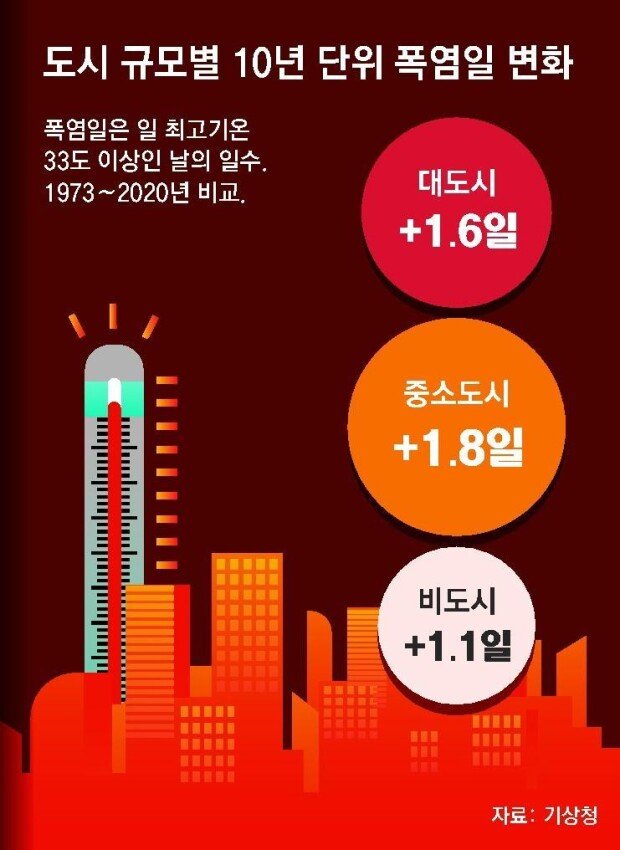'Urbanization effect on temperature rises,' says a study
'Urbanization effect on temperature rises,' says a study
Posted August. 17, 2023 10:06,
Updated August. 17, 2023 10:06


The Korea Meteorological Administration and the National Institute of Meteorological Sciences announced on Wednesday their findings of the urbanization effect on temperature rise, using observation data from a total of 30 places from 1973 to 2020. The study included eight large cities (population of one million or more), eight small and medium-sized cities (population of 300,000 or more), and 14 non-cities (population of around 100,000). The analysis shows that the number of heat wave days and the average temperature in small- and medium-sized cities, such as Cheongju in North Chungcheong Province and Gumi in North Gyeongsang Province, increased more than in large cities, such as Seoul, Busan, and Daegu.
Further, according to the Korea Meteorological Administration, the number of heat wave days increased by 1.4 days per 10 years in 16 cities in South Korea, and the average annual temperature increased by 0.37 degrees Celsius. In particular, the analysis shows that over the past 48 years, the number of heat waves in small- and medium-sized cities has increased more rapidly than in large cities as well as in non-cities. Heat waves increased by 1.8 days every 10 years in small- and medium-sized cities, compared to large cities (1.6 days).
Even when compared to closely located large cities, small- and medium-sized cities showed a clear trend of increasing heat wave days. While Daegu increased the number of heatwave days by 2.2 days every decade, neighboring Gumi in North Gyeongsang Province increased by 2.7 days. The number of heat wave days increased more rapidly in Cheongju in North Chungcheong (1.7 days) than in Daejeon (1.1 days), and in Pohang in North Gyeongsang Province (1.1 days) than in Ulsan (0.5 days).
In addition to the heat wave, the average temperature increase was higher in small- and medium-sized cities. The average temperature increase per decade was also relatively higher in small- and medium-sized cities (0.38 degrees Celsius) than in large cities (0.36 degrees Celsius). At first glance, this result differs from the common sense that “the bigger the city, the warmer it is due to the urbanization.”
“As urbanization progresses, the rise in temperature increases,” the Korea Meteorological Administration commented. “Also, urbanization has stagnated in large cities since the 1990s, while small- and medium-sized cities have been recently urbanizing with an increasing population.”
According to the study, the ‘urbanization effect’ affected the temperature rise in domestic cities by about 24 to 49 percent. Urbanization refers to the phenomenon in which a large number of people gather in a certain area due to industrialization, and the population density increases. The effect of urbanization on temperature rise was estimated to be greater in small- and medium-sized cities (29 to 50 percent) than in large cities (22 to 47 percent).
yeah@donga.com
Headline News
- Half of working seniors earn less than 1 million won per month
- S. Korea prepares to monitor N. Korean military activities amid POW concerns
- Shinsegae Group officially splits department stores and E-Mart affiliates
- Starbucks issues ‘come to the office 3 times a week or be fired’ notice
- Ha Hyeong-joo chosen as 2024 Sports Hero of Korea







